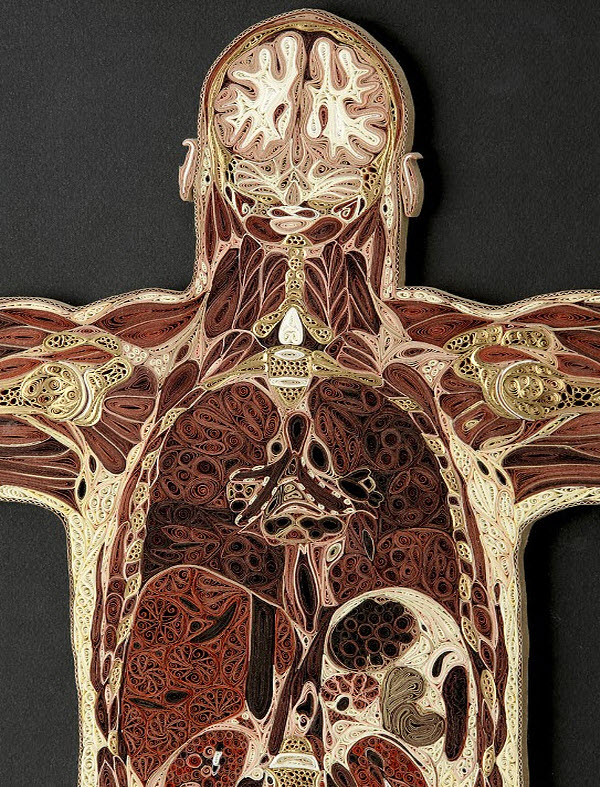In: paper assemblage

Asya Kozina | Baroque Paper Wigs, 2016
October 14, 2022Asya Kozina | Baroque Paper Wigs, 2016
Historical wigs always fascinated me, especially the Baroque era. This is art for art’s sake aesthetics for aesthetics, no practical sense. But they are beautiful. I made a series of wigs. Paper helps to highlight in this case the main form and not be obsessed [with] unnecessary details.
There is something both decadent and timeless about Kozina’s work. The idea of a peformative lens comes into play – as these intricate, hand made (with no digital tools) ‘wigs’ only attain their ultimate beauty when worn by one of Kozina’s models, and the rest of the team comes together (meshing together, perhaps, like the paper in the artist’s constructions) to produce a moment that has as much to do with art historical tropes, as seen in the paintings of Jacques Louis David or Caravaggio, as it does with contemporary couture and fashion. The artifice of the apple, the pale face perfectly dotted with subtle spots of rouge, the winsome look eschewing eye contact in one scene and the feigned precociousness of the model looking directly at us in another all suggest this might be a Jean-Honoré Fragonard (more late Baroque, with a touch of the playfulness of Rococo) except for the stark palette, only broken by the red of the apple.
I think of Fragonard as the old Russian Imperial court often looked to France for its ideal, and there’s a sentiment of the elaborate, exotic Ancien Régime to Kozina’s many works: another act of imitation from an artifice of pretension that was, of course, all about social class and cultural capital.
But Kozina does more than just mimic: several bodies of work – such as the more ballistic Baroque Punk or more erotic Eve – employ the history of fashion as a starting point for contemporary considerations and conversations.
More of her work can be seen on IG at @asya_kozina or at her site.
The photographer for this work is Anastasia Andreeva, with assistance from Dina Kharitonova. The makeup artists are Marina Sysolyatina and Svetlana Dedushkina.
~ Bart Gazzola
Read More
The Tissue Series | Lisa Nilsson
May 7, 2022The Tissue Series | Lisa Nilsson
Everything that has beauty has a body, and is a body;
everything that has being has being in the flesh:
and dreams are only drawn from the bodies that are.
(D. H. Lawrence)
Lisa Nilsson’s works are immediately visceral. But when you learn how they’re assembled, that bodily aesthetic, suggesting a wetness, a moistness, if you will, suddenly becomes dry and almost antiseptic.
This image is from her series of Anatomical Cross-Sections in Paper, and the artist offers the following about them and her process: These pieces are made of Japanese mulberry paper and the gilded edges of old books. They are constructed by a technique of rolling and shaping narrow strips of paper called quilling or paper filigree. Quilling was first practiced by Renaissance nuns and monks who are said to have made artistic use of the gilded edges of worn out bibles, and later by 18th century ladies who made artistic use of lots of free time. I find quilling exquisitely satisfying for rendering the densely squished and lovely internal landscape of the human body in cross section.
It’s interesting to consider the reference to bibles here – a tome that has much to say about the body and it’s ‘regulation’ (I’m old enough to remember the NEA ‘controversy’ when Mapplethorpe and Serrano were demonized by the Republican Helms, and how Lucy Lippard cast that in terms of adversarial religious dogma regarding interpolations of the body. Both artists mentioned here self identify as catholic and the late and unlamented Jesse Helms – their most bilious attacker – was a rabid evangelical). How the body is to be ‘regulated’ is also a fiery topic in the United States, right now….
I’m also reminded of the intersection between science and art, in terms of medical illustration, and an exchange from Katherine Dunn’s excellent novel Geek Love:
“What made you,” clearing my throat, “decide to be an artist?”
Her eyes flick at my feet under frowning brows. “No, no. A medical illustrator. For textbooks and manuals … ” Her tongue sneaks out at a corner of her mouth as she slaps stroke after vicious stroke onto the defenseless page. “See, photographs can be confusing. A drawing can be more specific and informative. It gets pretty red in there. Pretty hot and thick.”
More of Lisa Nilsson’s Tissue Series can be enjoyed here. Her work is meticulous and enthralling – like a bloodless autopsy.
All photographs here are by John Polak. ~ Bart Gazzola
Read More
Recent Comments